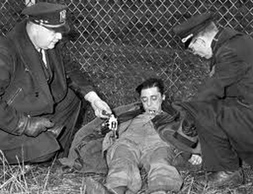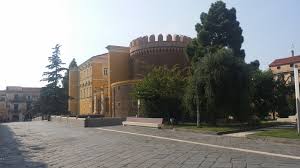Barber who became Al Capone’s henchman
 |
| Frank Nitti grew up in the Capone family's neighbourhood in Brooklyn, New York |
Nitti, who was raised in Brooklyn, New York, where he and Al Capone - his cousin - grew up, would eventually become Capone’s most trusted henchman in the Chicago mob he controlled. After Capone was jailed for 11 years for tax evasion, Nitti was ostensibly in charge of operations.
Unlike many of the American Mafia bosses in the early part of the 20th century, Nitti was not a Sicilian. His roots were in the heart of Camorra territory in the shadow of Vesuvius, his birthplace the town of Angri, 8km (5 miles) from nearby Pompei. Angri was also the hometown of Capone’s parents.
Young Francesco’s father died when he still a small child. His mother, Rosina, married again within a year to Francesco Dolengo, who emigrated to the United States in 1890. Nitti, his mother and his sister, Giovannina, left Italy to join him in 1893, settling in Navy Street, Brooklyn.
He was enrolled in a local school but left at around age 13, taking a job as a pinsetter in a bowling alley before becoming a barber. By this time he was well acquainted with criminal activities through the Navy Street Gang, of which a number of Capone’s brothers were members. He is said to have left home after falling out with his step-father.
 |
| Nitti worked for many years as the chief henchman to Chicago boss Capone |
Nitti renewed contacts with Greenberg and O’Banion and supported himself as a jewel thief, liquor smuggler and fence. Through his smuggling activities, Nitti came into contact with Chicago crime boss Johnny "Papa Johnny" Torrio and his lieutenant, Al Capone, who had been sent to assist Torrio by New York mobster Frankie Yale.
Capone, several years younger than Nitti, took over after Torrio survived an assassination attempt. Thanks to their family connections, Capone saw Nitti as someone he could trust and placed him in charge of his growing smuggling and distribution operation. With prohibition in place, Nitti imported whisky from Canada and sold it through a network of so-called speakeasies around Chicago.
His stock remained sufficiently high that when Capone was briefly imprisoned in 1929 he ran the organisation. He acquired the nickname “The Enforcer” but is thought to have shied away from violence himself, preferring to leave the dirty work to others.
In 1931, by then married for a second time to Anna after his first marriage ended in divorce, Nitti was sent to jail along with his boss on tax evasion charges. But where Nitti’s sentence was for 18 months, Capone was sent away for 11 years. It meant that Nitti was again in charge of the Chicago underworld.
 |
| Fearful of going to jail, Nitti killed himself in a railway yard close to his home in 1943 |
An attempt to remove Nitti was revealed in the aftermath of a police raid on his office by a team of Chicago police, headed by detectives Harry Lang and Harry Miller, during which Lang shot Nitti three times in the back and neck. He claimed he was acting in self defence and Nitti, who survived, was charged with attempted murder. During the trial, however. Miller testified that Lang had been given $15,000 to kill Nitti.
The end for Nitti came in 1943, when he and other leading figures in the so-called Chicago Outfit, including Ricca, were indicted on charges of extorting money from Hollywood movie studios, including Columbia Pictures, Metro-Goldwyn-Mayer, Paramount Pictures, RKO Pictures and 20th Century Fox, with the threat that they would face problems from the unions if they did not comply.
Having discovered during his first confinement that he suffered from severe claustrophobia, Nitti dreaded the idea of going to jail again, yet he was under pressure from Ricca to go before the grand jury and shoulder the blame himself rather than allow the Outfit to be broken up.
The day before his scheduled appearance, Nitti took his own life. He waited for his latest wife, Annette, to leave their home in the Chicago suburb of Riverside for church before downing several large drinks and walking five blocks to a railway yard, where he first tried to throw himself in front of a moving train but could not go through with it, and then, at the third attempt, shot himself in the head.
Nitti is buried at Mount Carmel Cemetery in Hillside, another urban village, about 24km (15 miles) west of downtown Chicago. His grave can be found left of the main gain, to the right pf which is the family plot containing the grave of Capone. The cemetery contains the graves of several other Chicago mobsters.
 |
| The Castello Doria in Angri is an unusual structure with two concentric towers, built by the Doria family |
Nitti’s hometown of Angri, situated where the urban sprawl that fans out around Vesuvius meets the Lattari mountains at the beginning of the Sorrentine Peninsula, is rich in history. It was the scene of the battle marked the victory of the Eastern Roman Empire over the Goths in 552 and became an important town under Bourbon rule and in the Kingdom of the Two Sicilies in the 19th century. The Castello Doria, notable for its two concentric towers, is an example of the town’s rich architectural heritage, dating back to the period between the 17th and 18th centuries in which Angri was controlled by the Doria family of Genova.
| The impressive Pontifical Shrine of the Blessed Virgin of the Rosary of Pompei |
A few kilometres from Angri in the direction of the Bay of Naples is Pompei, the town about 25km (15 miles) south of Naples built close to the ruins of the former Roman city. Like Angri, it is not without impressive achitecture, notably the Pontifical Shrine of the Blessed Virgin of the Rosary of Pompei, its towering cathedral. The cathedral was built from a dilapidated former church by Bartolo Longo, a lawyer who had returned to the Christian faith after a period following alternative beliefs, over a 28-year period between 1873 and 1901. The statue of the Virgin of the Rosary that sits atop the façade was carved from a single block of Carrara marble by Gaetano Chiaromonte.
More reading:
Frankie Yale: gang boss who employed the young Al Capone
How Lucky Luciano brought order to warring clans
The real life 'Godfather' - Carlo Gambino
Also on this day:
98AD: The Roman Emperor Trajan begins his reign
1901: The death of composer Giuseppe Verdi
1927: The birth of writer Giovanni Arpino
1962: The birth of composer Roberto Paci Dalò
Home










